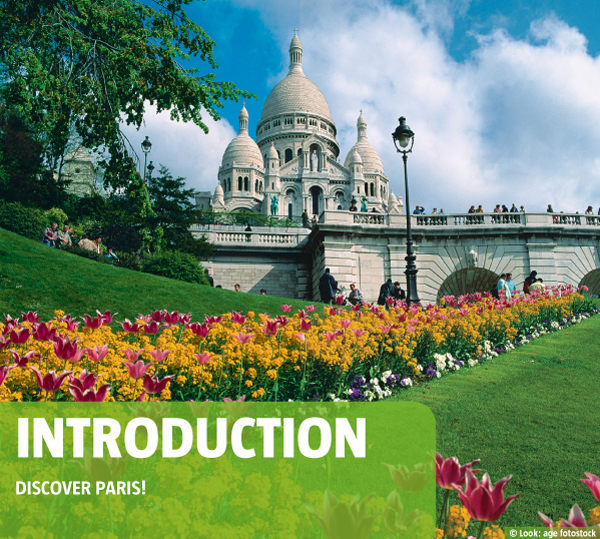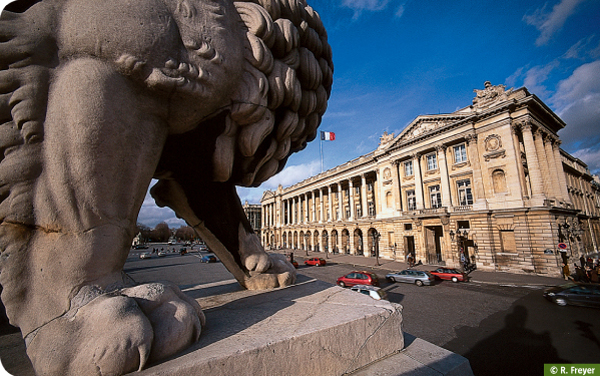
Photo: Sacré-Cœur |

Photo: Sacré-Cœur |
Paris: the city of love, fashion, gastronomy, art – and the city of lights. Paris has always been a metropolis where only the best is good enough, a city of superlatives. Faster, prettier, bigger, glossier than other cities in France, and comparable to other capital cities around the world such as London or New York. But few cities have the flair and romance of Paris: a stroll along the magnificent mile-long boulevard, Champs-Elysées, illuminated by 135,000 lights on a December evening or, from a street café, simply observing the colourful hustle and bustle of the vibrant Saint-Germain-des-Prés district at all hours, with its exuberant student life and many nightclubs, is enough to be infected by the charm of this city.
You can get an initial overview of the city from the observation platform (3 euros) on the sixth floor of the Centre Georges Pompidou, where you will find yourself in the middle of the city centre and high enough up to take in the sea of buildings. The city spreads out like an open history book beneath you. The bright mobile sculptures and cascading water of the Stravinsky Fountain lie at your feet and, further up, the towers of the famous Notre-Dame Cathedral loom into view. It stands on the Île de la Cité, the actual nucleus of the city, where the Parisii settled in the 3rd century BC. A bit further afield you’ll recognise the defiant towers of the former prison, la Conciergerie. Even further beyond and slightly to the right, the sprawling giant complex of the Louvre, a former royal palace that now houses the largest museum in the world, can be seen.
To the right behind you is the sparkling golden dome of Les Invalides, where Napoleon found his final resting place. Not far away the symbol of the city, the Eiffel Tower, looms on the horizon. To the far right and and to the west you can pick out the high-rises in La Défense, Europe’s largest office district. Look further to the right and north, where the dazzling white church, Sacré-Cœur, crowns the highest peak of the former artists’ hill, Montmartre.
For many centuries Paris has been the vibrant political, economical and cultural epicentre of France and one of the largest metropolises in the world. Paris was the residence of kings and the government, and by virtue of its numerous universities as far back as the Middle Ages was also recognised as a spiritual centre of Europe, the workplace for countless artists, writers and architects and a continual source of unrest and uprisings. Paris was the stage for many revolutions. The great revolution of 1789 known for its motto, ‘liberty, equality, fraternity’, even became a symbol of struggle against oppression, although the rights that were championed, especially in favour of the bourgeoisie, did not benefit the lower classes. Nevertheless, the French Revolution became a guiding light for freedom movements in many countries.

One of the most famous structures in the world and Paris’ landmark: the Eiffel Tower |
Strikes and demonstrations still frequently occur in Paris and, even if they no longer have universal historical significance, every French government still fears mobilisation in the streets. The challenges associated with a large, congested urban area – metropolitan Paris has a population of 11 million – are comparable with those of other cities of the same size. Huge traffic and environmental issues, lavish restoration projects and prohibitive rents, which continuously banish the socially vulnerable and the immigrants to the dreary apartment blocks in the suburbs, are ongoing struggles in Paris.
And yet the city has survived so much upheaval, political revolutions and crises without losing any of its fascination. What gives Paris its special flair? For some, it’s the grand promenades, ideal for strolling while for others it’s the lure of luxury boutiques on the Rue du Faubourg Saint-Honoré or shopping in world-renowned emporiums such as Galeries Lafayette or Printemps, famed for its extravagant decorations during the Christmas season. Others are content to explore the incredible variety of museums of international renown, sit in a street café or relax in one of the many parks – or just go with the flow.
Even the older Paris, the provincial, almost rural and unvarnished Paris still exists: attractive alleyways, crooked, low buildings with small cafés or pleasant restaurants, shops with enticing displays and chattering shopkeepers, the hubbub of activity wherever fresh produce is delivered, and fascinating markets with their typically colourful displays of fruit and vegetables, cheese, sausages and meat, pastries and cakes, with vendors loudly touting their wares. This folksy side of Paris is typical north and east of the city, as well as in Belleville, which, similar to the Goutte d’Or district, is inhabited by a large number of immigrants. Even the hills of Butte-aux-Cailles have partially retained much of their old Paris charm, with bistros and restaurants attracting young people to the area.
Paris has always been had a colourful mixture of people from various backgrounds. Previously it was the Bretons, Auvergneses, Alsatians and Basques who came to Paris in search of a better life and enriched the city – it was the Alsatians who first introduced their brasseries. Much later, Africans arrived, who maintain wonderfully colourful markets in Goutte d’Or every Sunday, and the Chinese, who settled in Place d’Italie and opened their businesses and restaurants.
Paris is multicultural and tolerant. A city that opened its arms to the politically persecuted, as well as revolutionaries such as Karl Marx and Leo Trotsky, and granted asylum to refugees from Nazi Germany. It is a city that has always attracted artists and it is no coincidence that major art movements such as Impressionism and Cubism found their beginnings here. Painters like Auguste Renoir, Vincent van Gogh and Pablo Picasso, writers such as Voltaire, Victor Hugo, Honoré de Balzac, Charles Baudelaire, Marcel Proust, Ernest Hemingway and Jean-Paul Sartre lived and worked here. Artists met in cafés and brasseries that have since become famous, on the left of the Seine – the rive gauche. This area, around the university buildings of the Sorbonne, has long been the intellectual heart of the city. The majority of these meeting places such as Procope, Le Flore, or the existentialists’ rendezvous Les Deux Magots in the Quartier Latin, and the Closerie des Lilas in the former artists’ district, Montparnasse, still exist today. These cafés and restaurants are a welcome place to stop by, especially for tourists and the well-heeled. But for poets and struggling artists they have long been too expensive, in addition to many other attractions in an affluent metropolis.
Paris, with its capricious beauty, was home to all sectors of society for centuries, but is now increasingly becoming a museum city, a capital for the rich and beautiful, rendered virtually unaffordable for the average citizen who has to make do with a tiny flat. A cappuccino can easily cost more than 5 euros, an evening meal served with wine, 60 euros or more. The extravagantly ornate palace façades with their grand entrances and marble staircases characteristic of the Haussmann era, often conceal shabby backstairs and cramped attic rooms lacking in proper insulation, which are ice cold in winter and boiling hot in summer. These ‘chambres des bonnes’, the former servants’ quarters, are now rented out to students or even teachers transferred to Paris from the provinces – 13m2 for up to 1,000 euros per month – and often without a WC and shower, albeit with a view of Sacré-Cœur or the Eiffel Tower. The government is now demanding a tax penalty for rents over 40 euros/m2. However, in light of the shortage of social housing, these unsavoury conditions will remain. And so the Parisians’ daily struggle against high prices, congested streets, crowded public transportation, crime and filth goes on – although most of them are proud of their city.
Many old buildings in Paris have been and continue to be torn down which always means the irrevocable loss of the city’s architectural history. New, ambitious projects are aimed ostensibly at making the city centre a place to live in again. Traffic is being curtailed by transport restriction schemes, new green and recreation areas along the Seine are being created, public transportation modernised and artists’ colonies established. La Défense, the business district situated to the west of the city gates which features some of the tallest buildings in Paris, is slated for expansion. High-rises are planned along the edge of the inner ring road, a new philharmonic hall is projected and Les Halles will be thoroughly revamped.

Opulent city palace from the 18th century: the Hôtel de la Marine on the Place de la Concorde |
All of this urban development will once again alter the face of a city that has already seen so many changes. The former President François Mitterrand, who launched his ‘Grands Projets’ – which include the glass pyramid at the Louvre, the Grande Arche at La Défense, the Opéra Bastille and the Très Grande Bibliothèque, completed more recently by his successor Jacques Chirac – once said: ‘You cannot have great politics without great architecture’. President Nicolas Sarkozy plans a museum of French history; however, architecture and large projects today have to come after citizens’ needs. The focus today is on making Paris a better place to live in, as opposed to erecting new buildings for reasons of prestige. Many young Parisians prefer to jet to London, Barcelona, Amsterdam or Berlin at the weekends, where life seems more glamorous than in Paris. Yet in the past the city has always proved it is capable of reinventing itself. Such resilience will carry Parisians confidently into the future.